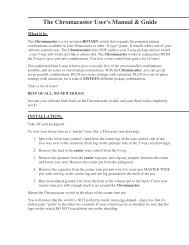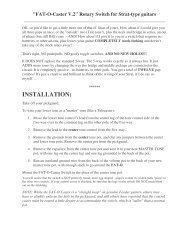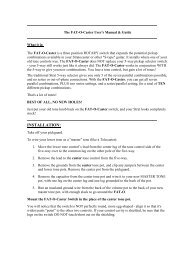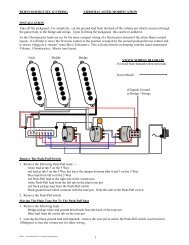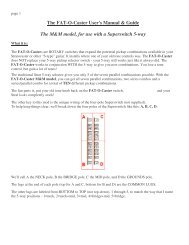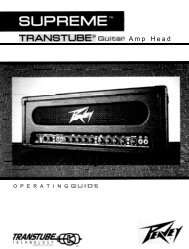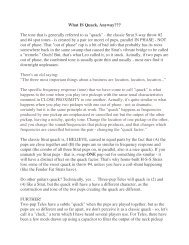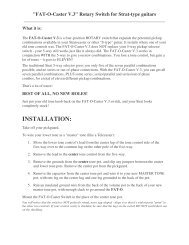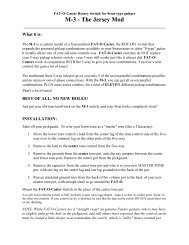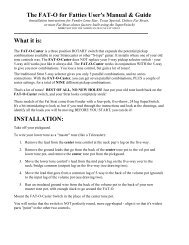A BRIEF DISCUSSION OF WIRING OPTIONS - Deaf Eddie
A BRIEF DISCUSSION OF WIRING OPTIONS - Deaf Eddie
A BRIEF DISCUSSION OF WIRING OPTIONS - Deaf Eddie
- No tags were found...
Create successful ePaper yourself
Turn your PDF publications into a flip-book with our unique Google optimized e-Paper software.
A <strong>BRIEF</strong> <strong>DISCUSSION</strong> <strong>OF</strong> <strong>WIRING</strong> <strong>OPTIONS</strong>For Two or More Pickups: Parallel, Series, and Phase OptionsPARALLEL:Most guitars produced today combine pups in a PARALLEL scheme. Pickups wired inparallel usually have a constant connection to the ground ("negative") side of the circuit,and their hot leads have a path to the output. Pickup selector switches usually interruptthe hot lead's path to the output, allowing you to select which pickup you hear. Two (ormore) pickups played in parallel combinations typically give you a "quack" tone - aquirky, sweet blend of the tone of the two pups. If you had a pair of identical pups wiredin parallel and looked at the circuit with a multimeter, your reading would typically beabout half of the impedance of either pup.SERIES:Pickups wired in SERIES cause the current to flow through first one pickup and then theother, effectively doubling the resistance/impedance of the circuit. This usually makes thetone of the combined pickups fatter or warmer than pickups played in parallel,emphasizing the fundamental more that the overtones. Series is usually slightly louder.If you had a pair of identical pups wired in series and looked at the circuit with amultimeter, your reading would typically be about twice of the impedance of either pup.
IN AND OUT <strong>OF</strong> PHASE:Once we start talking about phasing, there is some confusion about calling the negativelead from the pup's coil the "ground" lead. This is sloppy shorthand, and we all do it.Every magnetic guitar pickup consists of a coil (or pair of coils) that has a "positive" anda "negative" lead. In guitar electronics shorthand, we usually refer to the positive lead asthe HOT lead, and the negative lead as the GROUND lead. This is all well and good mostof the time, because typically, the positive lead goes to the hot side of the guitar's circuit,and the negative lead goes to ground. But, when we talk about phase, suddenly the hot isconnected to the ground and vice-verse… what we really mean is that when wired out ofphase, the positive lead is connected to the guitar's ground, and the negative lead isconnected to the hot side of the guitar's circuit."In phase," which is what EVERYBODY uses, typically sounds sweet, and produces a"quack" or "cluck" tone. The drawings in the "Parallel and Series" document illustratesin-phase connections, because both of the coils' hot leads go to the hot side of the circuit,and the coils' ground leads go to the ground side of the circuit. Teles and Strats, Les Paulsand SG's, Fenders and Squires, Gibsons and Epiphones, Gretsch, PRS, etc… everybodyuses IN PHASE (and, almost always parallel).If one pickup is OUT <strong>OF</strong> PHASE with another, when both are played, a lot offrequencies are "cancelled out" of the tone. The positive voltage one pickup creates isnegated by the negative voltage the other creates. Usually, lots of the fundamental iscancelled out, and the only tones that "escape" to be heard are the tones that areharmonically different between the two pickups - so you usually get very thin and"nasally" tones. The more alike the two pickups sound individually, the thinner their outof phase combo will sound. This is why you seldom see a phase-reverse option on a Strat- the middle pickup is too similar in tone to the other two, and is too close to them towork well in parallel/out of phase - the tone produced is just too thin for mostapplications. There's a way around it… but, more on that later.This usually brings up the question, "What does ONE pickup sound like, out of phase?"Actually, one pickup can NOT be out of phase - phase is a relationship, and requiresTWO (or more) pickups to be on at the same time. If you are playing ONE pickupALONE, there is no difference in its tone if it is wired in phase or out of phase to theother pickups - the phase relationship is only revealed when pickups are playedTOGETHER.Phase reversal is usually implemented with a switch, rather than hard-wired. The additionof a simple DP/DT toggle or push/pull pot can give just about any two-pickup guitar thenew, biting tone of pickups played out of phase.
Pickups wired PARALLEL/out of phase still both have their own paths to hot andground, but on ONE of the pickups, the leads are reversed. The tone produced is thin andnasally, and usually has perceivably less volume than other pickup combos. Meterreadings cannot determine phase - the reading for the circuit is that same asparallel/in-phase.Pickups wired SERIES/out of phase still require the current to flow through both coils,but (typically) the positive leads are tied together, and one coil's negative lead goes tohot, and the other's is then routed to ground. The advantage of the SERIES/out of phasetone over the parallel/out of phase tone is that because of the fact that the coils are wiredin SERIES, the output is louder, and therefore a better match in volume with the commonparallel in-phase tones. In other words, you don't get as much of a drop in gain when youswitch to out of phase if you are using a SERIES connection. This would be a goodoption to get some out of phase tones out of a Strat, without getting too thin. Again, meterreadings cannot determine phase - the impedance reading for the circuit is that same asseries/in-phase.
REAL-WORLD CONSIDERATIONS:Now, here's the "bad news:" With ANY SERIES (or out of phase) connection mod,IF the pickup's NEGATIVE LEAD has continuity with any metal parts - the cover or theframe - you MUST break this contact to isolate the metal cover or frame from the coil'snegative lead.WHY?Because, when you put the pup in SERIES - or out of phase - everything on the negativeside of the pickup's coil is now on the positive side of the guitar's circuit. That means thata metal cover or frame - and so, its mounting screws and springs, pole pieces etc - willhave continuity with the "hot" side of things. No arcs and sparks, smoke and flame, BUT,this may make the pickup more susceptible to hum, and it will certainly have the potentialfor unexpected and unwanted noises if you touch the pup or its screws while playing theguitar. If you accidentally touch it with a STRING, which is grounded, it will actuallySHUNT that pickup out of the tone (series) or mute the guitar (parallel).Because of this, I am in the habit of always recommending that if you just do the out ofphase mod, it is the NECK pup whose phase is reversed - most players are less likely totouch the neck pup than the bridge pup while playing. Also, if you are doing a series orout of phase mod to a Tele, it is FAR easier to mod the neck pup. Many Tele bridge pupshave an integral baseplate with continuity to their negative lead, and also require you toremove the bridge to get at them - too much work involved!SPECIFICALLY TELE:On your typical Tele neck pup, there is a metal cover. One of its mounting tabs, foldedunder the coil, usually has a small, short jumper to the eyelet on the pup's chassis thatconnects the coil to the negative lead. To "unground/reground" the cover, all you need todo is carefully clip that little jumper, breaking the connection, and then add a newINSULATED wire from the cover's tab back into the control cavity, where you willattach it to any ground. Please see the document “Unground/Regrounding a Tele.”SPECIFICALLY STRAT:On a stock-style Strat pup, luckily, this is seldom an issue. They are usually build on nonferrousframes, and have plastic covers - no worries about continuity with coil's the hot ornegative there. That's why I was able to so readily exploit all the series and series/out ofphase combos with my rotary switches.There IS a problem with some aftermarket custom Strat pups that are built with metalframes/chassis, and are wired up with only two conductors (leads). I simply do NOTrecommend the use of my switches - or that any series or phase mods - be attempted withpups built like that, as it has become popular to shield the underside of the pickguardaround the pickups. If the pup's metal frame has continuity to the negative lead, it willalso have continuity to ground through the mounting springs and screws touching theshielding foil on the back of the pickguard. Reverse the phase, or go series, on one ofthese pups, and you have an instant short circuit.MOST pup manufactures have wised-up to the mod market, and now, if using a metalframe, wire their pups THREE-CONDUCTOR - the hot lead, the negative lead, AND aseparate ground/shield wire (to ground the frame and/or cover) which has NO continuitywith the coil's negative lead.
SPECFICALLY HUMBUCKERS (and P90s):As for HUMBUCKERS, most modern/aftermarket FOUR-CONDUCTOR wired pickupsalso have a FIFTH conductor, which is typically a bare wire included inside the jacketedlead that will be the ground/shield connection to the chassis of the pup, and is completelyindependent and insulated from any leads from the coils. No worries, if this is the case.Where you run into the problem on humbuckers (and P90s) is if they are constructedusing a coaxial two-conductor lead with a braided/external shield, like the traditionalGibsons are made. The external braided conductor is typically soldered to the pup's metalchassis, and used as the ground/shield AND the coil's negative lead - yikes! Now youhave a pickup where not only the metal chassis, cover, and screws, but also the entirelength of the exposed braid on the lead has continuity with the ground of the guitar!These require some special treatment to do series and phase mods with.If you have an open-coil humbucker (no cover) or a P90, a simple trick is running alength of heat-shrink tubing over the entire length of the lead. This quick and dirtycompromise works, but the mounting screws and pole pieces are still "hot." It's less thanideal, but you CAN learn to live with it.However, this band-aid is even farther from ideal if your pickup has a metal cover. Now,you COULD, if you were an adventurous sort, remove the metal cover, go in andunsolder the coil's negative lead at the point where it is soldered to the pup's chassis andthe braided shield, and solder up a new negative lead for the coil (leaving the braidedshield soldered to the chassis as the ground conductor). That would certainly address allthe issues, but it's a long way to go and can be hazardous to the pickup and your wallet. Itis my strong recommendation that you should instead just shelf that old pickup intact,spend the bucks and get yerself a four-conductor pup to replace it.
For Humbucking Pickups: COOL COIL TRICKSHUMBUCKERS!There are two popular types of humbuckers: the stacked-coil humbuckers, typically madefor Strats, and the traditional side-by-side-coil humbuckers, which have the look that weall associate with the term "humbucker." For the remainder of this document, we willconcern ourselves with traditional side-by-side humbuckers. A traditional humbuckingpickup is comprised of two separate coils, which are wired in series. Usually, one of thecoils will have adjustable “screw” pole pieces (designed to adjust for string-to-stringbalance), and the other coil will have non-adjustable “slug” pole pieces. These two coilsare wound in opposite directions and are reverse (magnetic) polarity from each other(RW/RP) - which means they are IN phase sonically, but the reverse winding of the twocoils will cancel most radio-frequency noise, hum and interference. Hey, two coils inphase and in series? Well, no wonder humbuckers are characterized as having that"warm" tone!WHAT IS A COIL-SHUNT?A coil-shunt is a scheme (usually accomplished by a switch) that allows the current’spath to bypass one coil of a two-coil pickup. Usually, a jumper is added that routs bothoutputs of one coil the same side of the circuit, bypassing, or "shunting," that coil's effecton the tone and volume of the pickup. Hence, the name… A humbucker played with onecoil shunted will have a brighter tone and (typically) less output. Coil-shunts are an easyoption to give another voice to your instrument, for example, to get a "Fender-ish" tonefrom a "Gibson-ish" guitar, or breath a little air into a tone that is too dark. As a personalpreference, I like to shunt the slug coil and keep the screw coil active.HUMBUCKER COILS, RUN PARALLEL:For my personal tastes, I find coil-shunting a neck pup usually gives you a fabulous newtone. However, many bridge pups lose a bit too much "oomph" and sound weak whencoil-shunt. I believe this is because they are dealing with much less kinetic energy, andhalving the impedance has a more perceivable effect on the output power and volume.One of the things I often do to address this is to turn the pup around 180 degrees, so thatthe slug coil is closer to the bridge, putting the screw coil out where there is a bit moreenergy created. I think this warms the shunted tone back up a bit, and gives it just a tadmore energy and output.But the A-1, go-to remedy for this (for me, at least) is to give the bridge pup a coils-inparalleloption. This is bright, like a coil shunt, but a bit louder, and has the addedadvantage of still giving the pickup humbucking qualities. It's a win-win deal! Toaccomplish this, all you need to do is break to connection between the two coils and giveeach coil its own path to hot and ground. Where as you can coil-shunt two pickups on asingle DP/DT switch, this mod requires both poles of the switch, and so each switch canonly run one pickup. If I'm short on switches, this is a mod I usually do for the bridgepup, and not the neck pup. As I said, most neck pups will sound pretty nice with just yourstandard coil-shunt.My favorite trick is to have both a coil-shunt and a coils-parallel option for the bridgepup, and wire the switches in such a manner that the coils-parallel switch will overridethe coil-shunt switch. So, if you have a pair of humbucker and two switches, you canhave a coil-shunt switch that works both pups, and a coils-parallel switch for the bridgepup. I find this to be the most usable setup, concerning coil-shunts and splits. If you lookat my JP-Rethink and ES-333 schemes, you will see how I accomplish this.
A LOOK AT SOME HUMBUCKING PICKUPS:The original Gibson humbucker, which is the prototype for most of today's full-sizedhumbuckers, may appear to only have one lead (after looking at typical single-coilpickups with their two separate leads). This single lead is actually a two-conductorbraided shield lead. With this type of lead, the external metal braid serves as the shieldAND ground conductor, with the hot conductor carried on an insulated center (coaxial)wire.Many of today's "vintage-style" pups are built this way. If you have one of these, it hasNOT been manufactured with a coil-reconfiguration option available. To coil-shunt oneof these pickups, you will have to modify it by adding a new lead to the junction betweenthe coils. It's a tricky task, but not beyond most intermediate-level hot-rodders. Please askfor the document, “Adding A Coil-Shunt.” It’s not for the faint of heart, but do-able. Ihave done this to many Gibson 490R and 498T pups, which are commonly found in LesPauls and the like.Lucky for us, the custom/aftermarket pickup industry has developed a new humbuckerconstruction standard, so that most modern humbuckers of the “non-vintage” flavor comewith four-conductor wiring. Fortunately, this is one of the few instances where Gibsonactually may have been paying attention to the market, and they have begun producingfour-conductor humbuckers as well. I have also seen a few older import designs that arethree-conductor (some Ibanez, Squire, others), having the traditional hot and ground leadsAND a coil-shunt, but these are less common.Every manufacture seems to have come up with their own color code and coilarrangement - I call the coil connected to ground the “first coil” and the coil connected tohot the “second coil” – just to help us keep track of the signal path. It is important tohave the correct color code for the specific model pickup you are wiring, and know thearrangement. If you do not have this information about your pickup, please see thedocument “Unknown Color Code.”To coil-shunt a pickup, a "jumper" is added to the junction of the two leads which ties thecoils together leads (first coil "+" and second coil "-"). This jumper then goes to a switch,which allows it to either be OPEN or closed (connected). Open, and the pup stayshumbucker; closed, and the pup is coil-shunt - one coil is "bypassed." The closedconnection path can be to ground, or to the output of the pickup. If the connection goes toground, the first coil is shunted, and the second coil stays active. If the connection goes tothe hot, the second coil is shunted, and the first coil stays active.
ABOUT SPECIFIC HUMBUCKING PICKUPS:We’ll start with looking at a Gibson pickup’s color code.. Notice that the way Gibsonwires their pickups, the SCREW coil is “first” – the screw coil’s negative lead isconnected to ground. This means that you must run the coil-shunt jumper to the hot sideof the pickup’s output to keep the screw coil active.On DiMarzio pickups, it's actually a bit easier to wire the coil-shunt jumper - because ifyou follow the factory specs, the SLUG coil is first, connected to ground. If you switchthe shunt jumper to ground, it shunts the slug coil, leaving the screw (second) coil active,which is typically what you want.
On Seymour Duncans, if you follow the factory specs, the SCREW coil is first, closestto ground. This means that you must shunt S-D pups to hot to keep the screw coil active.Why did they build them that way? My BEST GUESS is because this is also the wayGibson builds their humbuckers (seee above). When you coil-shunt a Gibson humbucker,the coil-shunt jumper goes to the output of the pup - NOT ground - to shunt the slug coiland keep the screw coil working. Remember, the original Gibson humbucker wasdeveloped LONG ago, before hot-rodding yer axe was the rage it is today, and eventualmods to the pup were probably never a design consideration...FWIW: AN ALTERNATIVE FOR GIBSON AND S-D PUPS:The alternative to shunting-to-hot (which can be a pain) is to wire the pups in theopposite phase indicated in their documentation (by the Seymour Duncan color code, thiswould use the black wire as ground, and the green wire as hot - for Gibsons, the red wirewould be ground, and the black wire would be hot). If you wire BOTH pickups this wayon double-humbucker axes, it has the ease of the DiMarzio-style “shunt to ground”wiring, but keeps the screw coil active. On Fender AmStd Fat Strats, this is exactly whatFender did with the Seymour Duncan humbuckers they use so that they will play in phasewith the Fender single coils.If you are installing a Gibson or Seymour Duncan humbucker on a Strat, and you findthat this " reversed phase" installation makes the humbuckers sound out of phase with thebrand/model single coil pups that you are using, it is simply a matter of reversing thephase of the single coil pickups to get them all back IN phase. As the typical Strat-stylepup has no metal base plate or conductive parts, there are usually no repercussions toswapping the hot and ground leads. There are exceptions - some aftermarket Strat pupsDO have metal baseplates, and are two-conductor wired…sheesh!
In conclusion:If you have a guitar with a pair of pickups, armed with the information form my website,logic tells us that there are SIX possible combinations of pickups (tones) to chose from:bridge or neck alone; both parallel, both series; both parallel/out of phase or bothseries/out of phase. Any Les Paul, SG, or other two-pickup guitar can be modified with afew switches to give you these six tones, as opposed to the "stock" three offered by theunmodded guitar.If you have a pair of humbuckers, you can add a coil-shunt or two (or coils-parallel) andreally fine-tune your tone. Over twenty possible combos! It's Jimmy Page, déjà vu!Although, since some of the combos will sound similar, and some will just soundhorrible, I usually recommend that you select from your favorites and try to accomplishjust those combinations, rather than everything possible. Ergonomics comes into playhere - too many switches make for a confusing instrument! Consider the success of theTelecaster and its three simple tones…Speaking of Teles, Teles can easily take advantage of some of this info with theinstallation of the Fender 4-way or the four-pole/five-throw SuperSwitch, allowing youto select from four or five of the six possible combinations from two pickups, yetretaining a "stock" look.Three-pup Strats offer even more possible combinations, and some of the series andseries/out of phase tones can be really amazing. Using my rotary switches, you'll stilllook stock… NO NEW HOLES! Yup, here it is - the plug for the FAT-O-Caster! Hey,it's MY website, after all…



